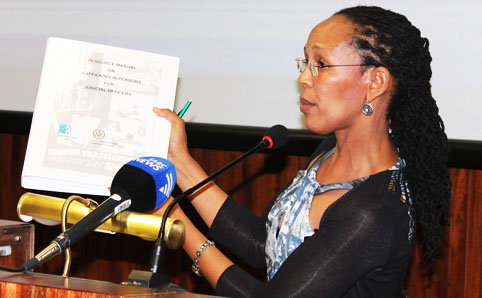 |
|
Judge Connie Mocumi, President of the South African Chapter of the International Association of Women Judges (SAC-IAWJ), during the launch of the Resource Manual on Trafficking in Persons for Judicial Officers.
Photo: Leonie Bolleurs
27 March 2012
|
On Human Rights Day the Department of Criminal and Medical Law in the Faculty of Law at the University of the Free State (UFS) hosted the launch of the Resource Manual on Trafficking in Persons for Judicial Officers compiled by the South African Chapter of the International Association of Women Judges (SAC-IAWJ).
The manual, which will be used by members of the South African judiciary, will equip officials in adjudicating the multifaceted crime of human trafficking.
“Presiding officers must be sensitised about the complexity of the crime. Human trafficking has many faces and presents itself in different ways. A person may for example be trafficked for sexual exploitation, forced labour, the removal of body parts, as well as forced marriages. Expert knowledge is needed to handle these cases effectively in court,” said Dr Kruger, also responsible for the human trafficking initiative in the Unit for Children's Rights at the UFS.
Prior to the launch, a total number of 300 judicial officers, including six judges from the Southern African Development Community (SADC) received training on human trafficking. After receiving this training, the officers were sensitised to scrutinise domestic violence cases as well as inter-country adoption cases in order to identify possible human trafficking activities.
As keynote speaker at the launch, Dr Beatri Kruger from the Department of Criminal and Medical Law at the UFS, said that human traffickers were running operations like a well-oiled machine. They have abundant and sophisticated resources and often bribe corrupt officials to further their criminal activities. In South Africa, people combating human trafficking struggle with a lack of resources as well as comprehensive legislation. Most cases are prosecuted under the Children’s Act and the Sexual Offences Amendment Act of 2007. Unfortunately, this legislation still leaves a gap in the prosecuting of perpetrators. Only trafficking cases where where children are trafficked can be prosecuted under the Children’s Act. In terms of the Sexual Offences Amendment Act perpetrators can be prosecuted for trafficking persons for sexual exploitation only, and not for labour of other forms of trafficking. Therefore the comprehensive Prevention and Combating of Trafficking in Persons Bill 2010 needs to be finalised to cover all forms of trafficking.
There are more slaves today than at any time in the history of humankind. “To combat this serious problem, we need to follow a holistic approach,” said Dr Kruger. This includes prevention (raising awareness), effective prosecution and suitable punishment, the protection of victims, and partnering with all relevant stakeholders, including people in the communities. Community members are often whistle blowers of this crime.
The President of the SAC-IAWJ, Judge Connie Mocumi, handed copies of the manual, a three-year project, to judicial officers present at the launch. The manual covers, among others, the definition of trafficking in persons, trafficking in persons in South Africa and the Southern African region, a legislative framework, victims’ rights and criminal proceedings.
“It is critical that judicial officers appreciate the phenomenon of trafficking in persons in its broader socio-economic context. Therein lays the ability to deal competently with the often-nuanced manifestation of this scourge. The incapacity to recognise these nuances can deny victims access to justice. In that regard, the manual, amongst others, is to become an important empowering adjudication tool for judicial officers,” said Judge Mocumi.
More copies will be printed and be ready for distribution by the beginning of May this year.
Judge Belinda van Heerden, who also attended the launch, said: “There is progress on the judicial and legislative front to bring wrongdoers to book. This manual will go a long way in giving judicial officers insight into the problem.”